
Schloss Sigmaringen
Encyclopedia
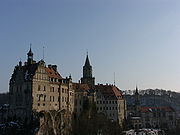
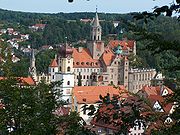
Hohenzollern-Sigmaringen
-Noble jurisdictions:Prince Karl Eitel of Hohenzollern-Sigmaringen, and descendants of his nephew Ferdinand ruled over the Kingdom of Romania, as Karl Eitel did not have children...
. Situated in the Swabian Alb
Swabian Alb
The Swabian Alps or Swabian Jura is a low mountain range in Baden-Württemberg, Germany, extending 220 km from southwest to northeast and 40 to 70 km in width. It is named after the region of Swabia....
(German: Schwäbische Alb) region of Baden-Württemberg
Baden-Württemberg
Baden-Württemberg is one of the 16 states of Germany. Baden-Württemberg is in the southwestern part of the country to the east of the Upper Rhine, and is the third largest in both area and population of Germany's sixteen states, with an area of and 10.7 million inhabitants...
, Germany, this castle dominates the skyline of the town of Sigmaringen
Sigmaringen
Sigmaringen is a town in southern Germany, in the state of Baden-Württemberg. Situated on the upper Danube, it is the capital of the Sigmaringen district....
. The castle was rebuilt following a fire in 1893, and only the towers of the earlier medieval fortress remain. Schloss Sigmaringen was a family estate of the Swabian Hohenzollern family, a cadet branch of the Hohenzollern family
House of Hohenzollern
The House of Hohenzollern is a noble family and royal dynasty of electors, kings and emperors of Prussia, Germany and Romania. It originated in the area around the town of Hechingen in Swabia during the 11th century. They took their name from their ancestral home, the Burg Hohenzollern castle near...
, from which the German Emperors and kings of Prussia came. During the closing months of World War II, Schloss Sigmaringen was briefly the seat of the Vichy French Government
Vichy France
Vichy France, Vichy Regime, or Vichy Government, are common terms used to describe the government of France that collaborated with the Axis powers from July 1940 to August 1944. This government succeeded the Third Republic and preceded the Provisional Government of the French Republic...
after France was liberated by the Allies
Allies of World War II
The Allies of World War II were the countries that opposed the Axis powers during the Second World War . Former Axis states contributing to the Allied victory are not considered Allied states...
. The castle and museums may be visited throughout the year, but only on guided tours.
Location
Sigmaringen is located on the southern edge of the Swabian AlbSwabian Alb
The Swabian Alps or Swabian Jura is a low mountain range in Baden-Württemberg, Germany, extending 220 km from southwest to northeast and 40 to 70 km in width. It is named after the region of Swabia....
, a plateau region in southern Baden-Württemberg. The Hohenzollern castle was built below the narrow Danube
Danube
The Danube is a river in the Central Europe and the Europe's second longest river after the Volga. It is classified as an international waterway....
river valley in the modern Upper Danube Nature Park
Naturpark Obere Donau
The Upper Danube Nature Park , founded in 1980, is located in the south of Baden-Württemberg in Germany and encloses primarily the districts of Tuttlingen and Sigmaringen. Its size encompassed initially 860 km² that were increased by about 500 km² in 2005. The headquarter of the Naturpark ...
(German: Naturpark Obere Donau). The castle rises above the Danube on a towering chalk
Chalk
Chalk is a soft, white, porous sedimentary rock, a form of limestone composed of the mineral calcite. Calcite is calcium carbonate or CaCO3. It forms under reasonably deep marine conditions from the gradual accumulation of minute calcite plates shed from micro-organisms called coccolithophores....
projection that is a spur of the white Jura Mountains
Jura mountains
The Jura Mountains are a small mountain range located north of the Alps, separating the Rhine and Rhone rivers and forming part of the watershed of each...
formation. The hill is known simply as the Schlossberg or Castle Rock. The Schlossberg is about 200 metres (656.2 ft) long and up to 35 metres (114.8 ft) above the river. On this free-standing towering rock, the princely Hohenzollern castle is the largest of the Danube valley castles. The sheer cliffs and steep sides of the tower made it a natural site for a well protected medieval castle.
Construction of the first castle
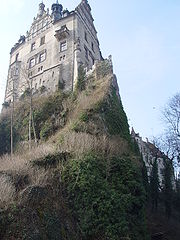
Early Middle Ages
The Early Middle Ages was the period of European history lasting from the 5th century to approximately 1000. The Early Middle Ages followed the decline of the Western Roman Empire and preceded the High Middle Ages...
, during the early 11th century. The castle was first mentioned in 1077 following the unsuccessful siege
Siege
A siege is a military blockade of a city or fortress with the intent of conquering by attrition or assault. The term derives from sedere, Latin for "to sit". Generally speaking, siege warfare is a form of constant, low intensity conflict characterized by one party holding a strong, static...
of Burg Sigmaringen by Rudolf of Rheinfelden in his fight against the King of Germany, Henry IV
Henry IV, Holy Roman Emperor
Henry IV was King of the Romans from 1056 and Holy Roman Emperor from 1084 until his forced abdication in 1105. He was the third emperor of the Salian dynasty and one of the most powerful and important figures of the 11th century...
. In 1083 a pair of brothers, Ludwig and Manegold von Sigmaringen, are listed as witnesses on a document for the Königseggwald
Königseggwald
Königseggwald is a town in the district of Ravensburg in Baden-Württemberg in Germany....
abbey.
Ludwig von Sigmaringen was married to Richinza von Spitzenberg, daughter of Berthold I.
Berthold II, Duke of Carinthia
Berthold II was an ancestor of the House of Baden, in addition to being Duke of Carinthia and Margrave of Verona....
von Zähringen. At the end of the 11th century he built a castle on the Spitzenberg at Kuchen
Kuchen
Kuchen , the German word for cake, is used in other languages as the name for several different types of sweet desserts, pastries, and gateaux...
, Germany. The castle and the surrounding land and villages were part of the inheritance of Richinza. From their marriage Richinza and Ludwig had four children; Mathilde von Spitzenberg, the wife of Aribo von Wertingen
Wertingen
Wertingen is a municipality in the district of Dillingen in Bavaria, Germany. It is located 13 km east of Dillingen, and 28 km northwest of Augsburg.The German band Killerpilze comes from Wertingen....
, the clergyman Ulrich von Sigmaringen, Ludwig II von Sigmaringen-Spitzenberg and Manegold von Sigmaringen-Spitzenberg. The three brothers, Ulrich, Ludwig and Mangold von Sigmaringen are named as the founders of the 11th-century St. George's Abbey in the Black Forest
St. George's Abbey in the Black Forest
St. George's Abbey in the Black Forest was a Benedictine monastery in St. Georgen im Schwarzwald in the southern Black Forest in Baden-Württemberg, Germany.-Foundation to Reformation:...
.
From 1133 until 1170 Rudolf von Sigmaringen-Spitzenberg, the son of Ludwig II, ruled at Sigmaringen. In 1183 Graf
Graf
Graf is a historical German noble title equal in rank to a count or a British earl...
Ludwig von Sigmaringen-Spitzenberg-Helfenstein
Ruine Helfenstein
Helfenstein Castle represents the remnants of the fortified castle Helfenstein of the counts of Helfenstein located above the city of Geislingen an der Steige, Baden-Württemberg, Germany.-History:...
, the son of Rudolf, is mentioned at the castle. In 1147 Ludwig as well as his father Rudolf and brother Ulrich II von Sigmaringen-Spitzenberg are mentioned in a document of Walter von Dillingen, Prince-Bishop of Augsburg
Prince-Bishopric of Augsburg
The Prince-Bishopric of Augsburg was one of the prince-bishoprics of the Holy Roman Empire, which belonged to the Swabian Circle.-Early period:...
, as lords of Spitzenberg-Sigmaringen.
Under the Helfenstein family, until 1290
Under the Helfenstein family, the castle was renovated around 1200. The castle was totally rebuilt with buckel stonesRustication (architecture)
thumb|upright|Two different styles of rustication in the [[Palazzo Medici-Riccardi]] in [[Florence]].In classical architecture rustication is an architectural feature that contrasts in texture with the smoothly finished, squared block masonry surfaces called ashlar...
(squared-off stones with a rounded outer surface). Between 1209 and 1258 the castle was occupied by Graf Gottried von Sigmaringen-Helfenstein and his son Graf Gebhard von Sigmaringen-Pietengau. In 1258 the cousin of Graf Gebhard, Graf Ulrich II. von Helfenstein, became the owner of Burg Sigmaringen. Later, Ulrich's daughter Agnes married Graf Ulrich I. von Montfort. Following the marriage in 1272, Sigmaringen was owned by the Counts of Montfort. Then, in 1290 Graf Hugo V. von Montfort, son of Ulrich I, sold the castle and the city of Sigmaringen to Albrecht and Rudolf von Habsburg.
Before 1325 Duke Luipold von Habsburg sold the castle and the county of Sigmaringen to the Count of Württemberg
Württemberg
Württemberg , formerly known as Wirtemberg or Wurtemberg, is an area and a former state in southwestern Germany, including parts of the regions Swabia and Franconia....
.
Werdenberg family 1399–1534
Finally in 1399 Count Eberhard von WürttembergEberhard III, Count of Württemberg
Eberhard III of Württemberg der Milde , ruled from 1392-1417 as the Count of Württemberg, then a part of the Holy Roman Empire.-Life:...
granted the castle and county of Sigmaringensein as well as the county of Veringen in Margraviate of Austria
March of Austria
The March of Austria was created in 976 out of the territory that probably formed the earlier March of Pannonia. It is also called the Margraviate of Austria or the Bavarian Eastern March. In contemporary Latin, it was the marchia Austriae, Austrie marchionibus, or the marcha Orientalis...
, to his uncle and liegeman Count Eberhard III. von Werdenberg (1387–1416) as a fief
Fiefdom
A fee was the central element of feudalism and consisted of heritable lands granted under one of several varieties of feudal tenure by an overlord to a vassal who held it in fealty in return for a form of feudal allegiance and service, usually given by the...
. His son Count Johann IV. von Werdenberg (1416–1465) and his wife Countess von Württemberg (disinherited by the House of Württemberg), in 1459 inherited the castle and county of Sigmaringen. To protect his land, in the following year he declared Sigmaringen an Austrian fief. From 1460 until 1500 the Counts von Werdenberg renovated the Burg (a military fortress) into Schloss Sigmaringen (a fortified residence), and expanded it to the dimensions which remain today. Toward the end of the 15th century they built two long, angular buildings in the north east. Then, in the early 16th century another wing was added to the west. The two round towers that flank the entrance to the castle also date from this time
Hugo IX. zu Sigmaringen (1459–1508), son of Johann IV., died without any male offspring. His sister Anna von Werdenberg married Count Friedrich von Fürstenberg
Fürstenberg (princely family)
Fürstenberg is the name of a noble house in Germany, based primarily in southern Baden-Württemberg. The family derives its name from the fortified town of the line's founder, Count Heinrich von Fürstenberg, today part of Hüfingen...
in 1516.
In 1521 Christoph (1494–1534), together with his brothers Johann VI. and Felix I. von Werdenberg, was granted the fief of Sigmaringen from Emperor Charles V
Charles V, Holy Roman Emperor
Charles V was ruler of the Holy Roman Empire from 1519 and, as Charles I, of the Spanish Empire from 1516 until his voluntary retirement and abdication in favor of his younger brother Ferdinand I and his son Philip II in 1556.As...
. Count Christoph married, after his first marriage to Eleonore Gonzaga remained childless, Johanna von Bröseln, widow of the Count Eitel Friedrich III. von Hohenzollern in 1526. All of his children died, except for his daughter Anna, who married Friedrichs II. von Fürstenberg.
According to the Zimmern Chronicle
Zimmern Chronicle
The Zimmern Chronicle is a family chronicle describing the lineage and history of the noble family of Zimmern, based in Meßkirch, Germany. It was written in a Swabian variety of Early New High German by Count Froben Christoph von Zimmern...
in 1530, as Count Felix I was in the bath house with Leonora Werdenberg (the illegitimate daughter of Hugo IX and the mistress of Felix and Christoph von Werdenberg) the bath house fire was allowed to spread, leading to a fire that expanded throughout the outbuildings around the castle.
In 1534, following the death of the last male member of the Werdenberger family, Count Friedrich von Fürstenberg demanded the Werdenberger lands. However, King Ferdinand I
Ferdinand I, Holy Roman Emperor
Ferdinand I was Holy Roman Emperor from 1558 and king of Bohemia and Hungary from 1526 until his death. Before his accession, he ruled the Austrian hereditary lands of the Habsburgs in the name of his elder brother, Charles V, Holy Roman Emperor.The key events during his reign were the contest...
granted the fief of Sigmaringen and Veringen, in 1535, to Charles I of Hohenzollern
Zollern
Zollern, from 1218 Hohenzollern, was a county of the Holy Roman Empire. Its ruling dynasty was the House of Hohenzollern, a Swabian noble family first mentioned in 1061. They named their estates after Hohenzollern Castle at the Swabian Alb; its capital was Hechingen...
(1516–1576), the son from Johanna von Bröseln's first marriage with Friedrich III. von Hohenzollern.
The Hohenzollern and Hohenzollern-Sigmaringen families, 1535–1850
Charles I was the first Hohenzollern to rule in Sigmaringen.In 1539 there was another fire that damaged the castle.
A year later, in 1540, Sigmaringen and Veringen were transferred to the House of Hohenzollern as part of the Pfullendorf
Pfullendorf
Pfullendorf is a small historic city in the district of Sigmaringen in Baden-Württemberg in Germany.-Geography:Its location is in the district of Sigmaringen, 25 km north of Lake Constance and south of the Danube valley and therefore on the continental divide between the watersheds of the...
agreement (German: Pfullendorfer Vertrag). Count Charles I. von Hohenzollern occupied the castle.
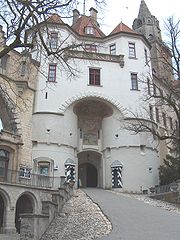
Charles II, Count of Hohenzollern-Sigmaringen
Charles II, Count of Hohenzollern-Sigmaringen became Count of Hohenzollern-Sigmaringen in 1576 and remained so until his death....
(1547–1606), son of Charles I was the count of Sigmaringen from 1576 until 1606. He was also the founder of the Hohenzollern-Sigmaringen
Hohenzollern-Sigmaringen
-Noble jurisdictions:Prince Karl Eitel of Hohenzollern-Sigmaringen, and descendants of his nephew Ferdinand ruled over the Kingdom of Romania, as Karl Eitel did not have children...
line of the Hohenzollern family. Under Charles II the castle was renovated. Between 1576 and 1606 the gatehouse was expanded to cover the entrance to the castle and a new church was built near the castle.
In 1576 the House of Hohenzollern split into four lines, Hohenzollern (died out in 1602), Hohenzollern-Haigerloch
House of Hohenzollern-Haigerloch
The House of Hohenzollern-Haigerloch was a sub-branch of the senior Swabian branch of the Hohenzollern dynasty whose more famous younger Franconian branch became Burgraves of Nuremberg, Margraves of Brandenburg, Kings of Prussia, and finally Emperors of Germany...
(absorbed by Hohenzollern-Sigmaringen after 1630), Hohenzollern-Hechingen
Hohenzollern-Hechingen
Hohenzollern-Hechingen was a county and principality in southwestern Germany. Its rulers belonged to a branch of the senior Swabian branch of the Hohenzollern dynasty.-History:...
(died out in 1869) und Hohenzollern-Sigmaringen
Hohenzollern-Sigmaringen
-Noble jurisdictions:Prince Karl Eitel of Hohenzollern-Sigmaringen, and descendants of his nephew Ferdinand ruled over the Kingdom of Romania, as Karl Eitel did not have children...
. Sigmaringen was the main residence of the family of Hohenzollern-Sigmaringen from 1576 until 1850.

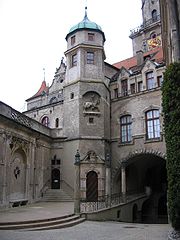
Graf
Graf is a historical German noble title equal in rank to a count or a British earl...
) to the rank of Princes of the Holy Roman Empire
Princes of the Holy Roman Empire
The term Prince of the Holy Roman Empire denoted a secular or ecclesiastical Imperial State, who ruled over an immediate fief directly assigned by the Holy Roman Emperor...
(German: Reichsfürst). Johann then became the first prince
Fürst
Fürst is a German title of nobility, usually translated into English as Prince.The term refers to the head of a principality and is distinguished from the son of a monarch, who is referred to as Prinz...
(German: Fürst) of Hohenzollern-Sigmaringen.
During the Thirty Years' War
Thirty Years' War
The Thirty Years' War was fought primarily in what is now Germany, and at various points involved most countries in Europe. It was one of the most destructive conflicts in European history....
, the castle was besieged by Swedish
Swedish Empire
The Swedish Empire refers to the Kingdom of Sweden between 1561 and 1721 . During this time, Sweden was one of the great European powers. In Swedish, the period is called Stormaktstiden, literally meaning "the Great Power Era"...
troops in 1632, and retaken by the Imperial troops in the following year. During the attack by Imperial troops under General Horn, the eastern section of the castle was destroyed by fire.
Before the siege, Johann fled to Bavaria
Bavaria
Bavaria, formally the Free State of Bavaria is a state of Germany, located in the southeast of Germany. With an area of , it is the largest state by area, forming almost 20% of the total land area of Germany...
. He would remain in Bavaria until his death, at age 60, in 1638.
Johann's son, Meinrad I (1605–1681), was the prince from 1638 until 1681. Meinrad had the burned eastern wing rebuilt during 1658 and 1659 by the master builder Michael Beer. Both eastern buildings, built when the Werdenberg family owned Sigmaringen, were combined under a single roof.
Maximilian (1636–1689), son of Meinrad I, was prince of Hohenzollern-Sigmaringen from 1681 until 1689.
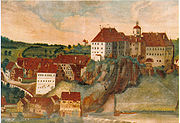
Haigerloch
-Geography:-Geographical situation:Haigerloch lies at between 430 and 550 metres elevation in the valley of the Eyach, which forms two loops in a steep shelly limestone valley...
. His son, Josef (1702–1769) ruled from 1715 until 1769. In 1724 Josef ordered the construction of the Marstalles or royal stables. In addition to this construction, in 1736 he had the castle modernized and the Knights' Hall (German: Rittersaal) was built. In 1867 it was refurnished and renamed the Ancestors' Hall (German: Ahnensaal). His son, Karl Friedrich reigned from 1769 until 1785.
Karl Friedrich's son, Anton Aloys
Anton Aloys, Prince of Hohenzollern-Sigmaringen
Anton Aloys, Prince of Hohenzollern-Sigmaringen was Prince of Hohenzollern-Sigmaringen.He married Princess Amalie Zephyrine of Salm-Kyrburg in 1782 and was the father of Charles, Prince of Hohenzollern-Sigmaringen. He was the paternal great-grandfather of Prince Karl of Hohenzollern-Sigmaringen,...
(1762–1831), reigned from 1785 until 1831. Between 1815 and 1817 he had the granary rebuilt as a five-story knights' building, which became known as Wilhelm's building (German: Wilhelmsbau).
Prince Karl
Charles, Prince of Hohenzollern-Sigmaringen
Charles, Prince of Hohenzollern-Sigmaringen was Prince of Hohenzollern-Sigmaringen from 1831 to 1848.In 1833 Karl called a constitutional assembly together and created a constitutional charter that would be the law in his lands...
(1785–1853), the son of Anton Aloys, ruled from 1831 until 1848. In 1833 Karl called a constitutional assembly (German: Landtag) together and created a constitutional charter that would be the law in his lands. He founded a hospital for his subjects, and had the Ständehaus built on the modern Leopoldsplatz in Sigmaringen (today owned by the Hohenzollerischen Landesbank). Karl also removed the burden of serf
SERF
A spin exchange relaxation-free magnetometer is a type of magnetometer developed at Princeton University in the early 2000s. SERF magnetometers measure magnetic fields by using lasers to detect the interaction between alkali metal atoms in a vapor and the magnetic field.The name for the technique...
dom and various other medieval laws
German town law
German town law or German municipal concerns concerns town privileges used by many cities, towns, and villages throughout Central and Eastern Europe during the Middle Ages.- Town law in Germany :...
. During the German Revolution of 1848
Revolutions of 1848 in the German states
The Revolutions of 1848 in the German states, also called the March Revolution – part of the Revolutions of 1848 that broke out in many countries of Europe – were a series of loosely coordinated protests and rebellions in the states of the German Confederation, including the Austrian Empire...
Karl abdicated in favor of his son, Karl Anton, on 27 August 1848. In recognition of Karl's efforts to improve the lives of his subjects, in 1857 the hospital that he built was renamed the Fürst-Carl-Landesspital (Prince Carl Regional Hospital). In 1869 Karl Anton, following the death of Konstantin the last prince of Hohenzollern-Hechingen, annexed the lands of Hohenzollern-Hechingen and became the prince of Hohenzollern.
A destination for the rich and powerful
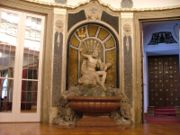
Keep
A keep is a type of fortified tower built within castles during the Middle Ages by European nobility. Scholars have debated the scope of the word keep, but usually consider it to refer to large towers in castles that were fortified residences, used as a refuge of last resort should the rest of the...
, removed the old roof and topped the keep with a new pointed roof. In the following year, the Ancestors' Hall (German: Ahnensaal) was rebuilt.
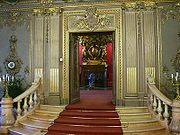
Leopold (1835–1905), the son of Karl Anton, was offered the Spanish crown
Spanish monarchy
The Monarchy of Spain, constitutionally referred to as The Crown and commonly referred to as the Spanish monarchy or Hispanic Monarchy, is a constitutional institution and an historic office of Spain...
after the Spanish Revolution of 1868
Glorious Revolution (Spain)
The Glorious Revolution took place in Spain in 1868, resulting in the deposition of Queen Isabella II.An 1866 rebellion led by General Juan Prim and a revolt of the sergeants at San Gil barracks, in Madrid, sent a signal to Spanish liberals and republicans that there was serious unrest with the...
overthrew Queen Isabella II
Isabella II of Spain
Isabella II was the only female monarch of Spain in modern times. She came to the throne as an infant, but her succession was disputed by the Carlists, who refused to recognise a female sovereign, leading to the Carlist Wars. After a troubled reign, she was deposed in the Glorious Revolution of...
. He was supported by the Prussian
Kingdom of Prussia
The Kingdom of Prussia was a German kingdom from 1701 to 1918. Until the defeat of Germany in World War I, it comprised almost two-thirds of the area of the German Empire...
Prime Minister Otto von Bismarck
Otto von Bismarck
Otto Eduard Leopold, Prince of Bismarck, Duke of Lauenburg , simply known as Otto von Bismarck, was a Prussian-German statesman whose actions unified Germany, made it a major player in world affairs, and created a balance of power that kept Europe at peace after 1871.As Minister President of...
, but opposed by the French emperor Napoleon III. Leopold was forced to decline the offer, but the extra demands made by the French government and the sending of the Ems Telegram
Ems Dispatch
The Ems Dispatch , sometimes called the Ems Telegram, caused France to declare the Franco-Prussian War in July 1870. The actual dispatch was an internal message from the Prussian King's vacationing site to Bismarck in Berlin, reporting demands made by the French ambassador; it was Bismarck's...
resulted in the Franco-Prussian War
Franco-Prussian War
The Franco-Prussian War or Franco-German War, often referred to in France as the 1870 War was a conflict between the Second French Empire and the Kingdom of Prussia. Prussia was aided by the North German Confederation, of which it was a member, and the South German states of Baden, Württemberg and...
of 1870–71, which led to the fall of emperor Napoleon III and the setting up of the French Third Republic
French Third Republic
The French Third Republic was the republican government of France from 1870, when the Second French Empire collapsed due to the French defeat in the Franco-Prussian War, to 1940, when France was overrun by Nazi Germany during World War II, resulting in the German and Italian occupations of France...
. Following the war and the death of Karl Anton, he ruled as prince of the Houses of Hohenzollern-Sigmaringen and Hohenzollern from 1885 until his death in 1905.
In 1893 the eastern wing burned and was nearly totally destroyed. Starting in 1895, the construction manager Johannes de Pay and the Munich
Munich
Munich The city's motto is "" . Before 2006, it was "Weltstadt mit Herz" . Its native name, , is derived from the Old High German Munichen, meaning "by the monks' place". The city's name derives from the monks of the Benedictine order who founded the city; hence the monk depicted on the city's coat...
architect Emanuel von Seidl rebuilt the destroyed section. In 1899 and 1906, other sections of th castle were redone in the eclectic style (a combination of Romanesque
Romanesque architecture
Romanesque architecture is an architectural style of Medieval Europe characterised by semi-circular arches. There is no consensus for the beginning date of the Romanesque architecture, with proposals ranging from the 6th to the 10th century. It developed in the 12th century into the Gothic style,...
, Gothic
Gothic architecture
Gothic architecture is a style of architecture that flourished during the high and late medieval period. It evolved from Romanesque architecture and was succeeded by Renaissance architecture....
and mostly Renaissance
Renaissance architecture
Renaissance architecture is the architecture of the period between the early 15th and early 17th centuries in different regions of Europe, demonstrating a conscious revival and development of certain elements of ancient Greek and Roman thought and material culture. Stylistically, Renaissance...
styles) that was common at the time. The Portuguese Gallery (German: Portugiesische Galerie) was built during this reconstruction. The construction continued under Leopold's son, Wilhelm
Wilhelm, Prince of Hohenzollern
William, Prince of Hohenzollern was the eldest son of Leopold, Prince of Hohenzollern and Infanta Antónia of Portugal. His maternal grandparents were Maria II of Portugal and her King consort Ferdinand II of Portugal.William was an older brother of Ferdinand I of Romania...
(1864–1927) who was prince of the Houses of Hohenzollern-Sigmaringen and Hohenzollern from 1905 until 1927.
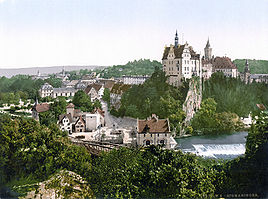
Gothic Revival architecture
The Gothic Revival is an architectural movement that began in the 1740s in England...
tower made from tuff
Tuff
Tuff is a type of rock consisting of consolidated volcanic ash ejected from vents during a volcanic eruption. Tuff is sometimes called tufa, particularly when used as construction material, although tufa also refers to a quite different rock. Rock that contains greater than 50% tuff is considered...
stone.
Leopold's son Friedrich
Friedrich, Prince of Hohenzollern
Frederick, Prince of Hohenzollern He was the eldest son of William, Prince of Hohenzollern and Princess Maria Teresa of Bourbon-Two Sicilies...
(1891–1965) was the prince of the house from 1927 until 1965. He opened the carriage
Carriage
A carriage is a wheeled vehicle for people, usually horse-drawn; litters and sedan chairs are excluded, since they are wheelless vehicles. The carriage is especially designed for private passenger use and for comfort or elegance, though some are also used to transport goods. It may be light,...
house in the lower story of the museum as an early history museum.
Seat of the Vichy Government
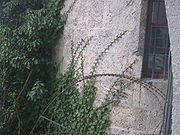
Allies of World War II
The Allies of World War II were the countries that opposed the Axis powers during the Second World War . Former Axis states contributing to the Allied victory are not considered Allied states...
invasion
D-Day
D-Day is a term often used in military parlance to denote the day on which a combat attack or operation is to be initiated. "D-Day" often represents a variable, designating the day upon which some significant event will occur or has occurred; see Military designation of days and hours for similar...
of France, the French Vichy Regime
Vichy France
Vichy France, Vichy Regime, or Vichy Government, are common terms used to describe the government of France that collaborated with the Axis powers from July 1940 to August 1944. This government succeeded the Third Republic and preceded the Provisional Government of the French Republic...
was moved from France into Schloss Sigmaringen. The princely family was forced by the Gestapo
Gestapo
The Gestapo was the official secret police of Nazi Germany. Beginning on 20 April 1934, it was under the administration of the SS leader Heinrich Himmler in his position as Chief of German Police...
out of the castle and moved to Schloss Wilflingen. The French authors Louis-Ferdinand Céline
Louis-Ferdinand Céline
Louis-Ferdinand Céline was the pen name of French writer and physician Louis-Ferdinand Destouches . Céline was chosen after his grandmother's first name. He is considered one of the most influential writers of the twentieth century, developing a new style of writing that modernized both French and...
and Lucien Rebatet
Lucien Rebatet
Lucien Rebatet was a French author, journalist and intellectual, an exponent of fascism and virulent antisemite.-Early life:...
, who had written political and anti-semitic works, feared for their safety and fled to Sigmaringen with the Vichy government. Céline's 1957 novel D'un château l'autre
Castle to Castle
Castle to Castle is the English title of the 1957 novel by Louis-Ferdinand Céline, titled in French D'un château l'autre. The book was written about his experiences in exile at Sigmaringen, Germany, with the Vichy French government towards the end of World War II.-Legacy:Castle to Castle was...
, (English: From one castle to another) describes the end of the war and the fall of Sigmaringen on 22 April 1945. The book was made into a German movie in 2006, through the German media companies ZDF
ZDF
Zweites Deutsches Fernsehen , ZDF, is a public-service German television broadcaster based in Mainz . It is run as an independent non-profit institution, which was founded by the German federal states . The ZDF is financed by television licence fees called GEZ and advertising revenues...
and Arte
Arte
Arte is a Franco-German TV network. It is a European culture channel and aims to promote quality programming especially in areas of culture and the arts...
, called Die Finsternis (English: The Darkness).
The modern castle
During the 1970s, following a crisis in the steel industry, Frederick WilliamFrederick William, Prince of Hohenzollern
Friedrich Wilhelm, Prince of Hohenzollern was the head of the Princely House of Hohenzollern-Sigmaringen.-Biography:Friedrich Wilhelm was born in Schloss Umkirch...
had to sell some of the family property to support the Hüttenwerkes Laucherthal (English: Laucherthal Steel Works). Since the death of his wife Margarita
Princess Margarita of Leiningen
Princess Margarita of Leiningen was a Princess of Leiningen and Princess consort of Hohenzollern...
in 1996 Prince Frederick William lived in a country estate in Jagdschloss Josefslust between Krauchenwies
Krauchenwies
Krauchenwies is a municipality in the district of Sigmaringen in Baden-Württemberg in Germany.-Geography:Krauchenwies lies about 10 km south of Sigmaringen and 25 km north of Lake Constance...
and Sigmaringen. His son and heir Karl Friedrich
Karl Friedrich, Hereditary Prince of Hohenzollern
Karl Friedrich, Prince of Hohenzollern is the eldest son of the late Friedrich Wilhelm, Prince of Hohenzollern and Princess Margarita of Leiningen...
lives in the Sommerschloss in Krauchenwies. The castle is occupied by the management for the business interests of the prince as well as the museum.
Castle Site
The modern Schloss Sigmaringen owes its current size and appearance to three construction periods.- The medieval castle from the 11th to 13th centuries, built under the Counts of Sigmaringen-Spitzenberg and Spitzenberg-Helfenstein.
- The renovations and expansion of the castle under Counts of Werdenberg.
- The renovations to make the castle into a princely residence for the Princes of Hohenzollern-Sigmaringen
Fortress and protective walls

The foundations of the castle were between 3 and 2.5 m (9.8 and 8.2 ft) thick. The, originally, four story keep walls taper slightly to between 2 or thick. The walls are built in the buckel stone style out of a mixture of limestone
Limestone
Limestone is a sedimentary rock composed largely of the minerals calcite and aragonite, which are different crystal forms of calcium carbonate . Many limestones are composed from skeletal fragments of marine organisms such as coral or foraminifera....
and Nagelfluh
Molasse
The term "molasse" refers to the sandstones, shales and conglomerates formed as terrestrial or shallow marine deposits in front of rising mountain chains. The molasse is deposited in a foreland basin, especially on top of flysch, for example that left from the rising Alps, or erosion in the Himalaya...
, a conglomerate rock
Conglomerate (geology)
A conglomerate is a rock consisting of individual clasts within a finer-grained matrix that have become cemented together. Conglomerates are sedimentary rocks consisting of rounded fragments and are thus differentiated from breccias, which consist of angular clasts...
found in the area. The keep could be entered through a nearly 8 metres (26.2 ft) high entrance on the courtyard side. To the north of the keep, next to the wall tower, is the castle gate with a gatehouse
Gatehouse
A gatehouse, in architectural terminology, is a building enclosing or accompanying a gateway for a castle, manor house, fort, town or similar buildings of importance.-History:...
. The 2.28 metres (7.5 ft) wide and 3.96 metres (13 ft) high castle gate was built as a semi-circular entrance with rounded stones and soldiers carved as capitals
Capital (architecture)
In architecture the capital forms the topmost member of a column . It mediates between the column and the load thrusting down upon it, broadening the area of the column's supporting surface...
on the columns. Currently, the castle gate is located at the upper end of the steeply inclined entry hall. The flat top of the hill was surrounded by a curtain wall
Curtain wall (fortification)
A curtain wall is a defensive wall between two bastions of a castle or fortress.In earlier designs of castle the curtain walls were often built to a considerable height and were fronted by a ditch or moat to make assault difficult....
. From the original fortified house with its blind arch
Blind arch
A blind arch is an arch found in the wall of a building which has been infilled with solid construction so it cannot serve as a passageway, door, or window. The term is most often associated with masonry wall construction, but is also found in other types of construction such as light frame...
es and enclosed kitchen, located on the highest point of the cliff, the arches and portions of the wall are still visible in the outer wall. On the southside, about 6 metres (19.7 ft) below the keep, a 10–12 m (32.8–39.4 ft) wide inner courtyard was located. Today this area is occupied by the Hall of Weapons. On the east side near the mill
Gristmill
The terms gristmill or grist mill can refer either to a building in which grain is ground into flour, or to the grinding mechanism itself.- Early history :...
is a small 2 metres (6.6 ft) wide opening in the wall, which was most likely a lower castle gate. The 6 to 8 m (19.7 to 26.2 ft) high outer curtain wall is the foundation of the modern castle building. In the north inner wall of the keep is a small opening, which likely was a hidden passage leading to the Danube.
Sights
The castle rooms on the tour are full of ornate furniture, paintings and valuable porcelainPorcelain
Porcelain is a ceramic material made by heating raw materials, generally including clay in the form of kaolin, in a kiln to temperatures between and...
objects. The rooms give the visitor a taste of the lifestyle of the nobility in previous centuries. Collections of pre- and ancient historical objects are on display as well as works from swabia
Swabia
Swabia is a cultural, historic and linguistic region in southwestern Germany.-Geography:Like many cultural regions of Europe, Swabia's borders are not clearly defined...
n artists, carvers and metalworkers. The Hall of Weapons displays one of the largest private weapon collections in Europe, covering everything from the Middle Ages to modern times. The Marstall museum contains the princely fleet of carriages.
The weapon collection
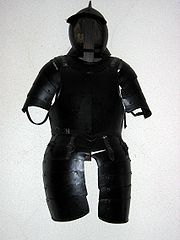
Samurai
is the term for the military nobility of pre-industrial Japan. According to translator William Scott Wilson: "In Chinese, the character 侍 was originally a verb meaning to wait upon or accompany a person in the upper ranks of society, and this is also true of the original term in Japanese, saburau...
.
In the Galeriebau (English: Gallery Building), built from 1862 to 1867 under Prince Karl Anton, west of the castle is a collection of medieval torture instruments. The torture chamber with its instruments illustrates an earlier sense of justice.
Pre and Ancient History Collection
In addition to the torture museum, the Galeriebau also houses a PrePrehistory
Prehistory is the span of time before recorded history. Prehistory can refer to the period of human existence before the availability of those written records with which recorded history begins. More broadly, it refers to all the time preceding human existence and the invention of writing...
and Ancient history
Ancient history
Ancient history is the study of the written past from the beginning of recorded human history to the Early Middle Ages. The span of recorded history is roughly 5,000 years, with Cuneiform script, the oldest discovered form of coherent writing, from the protoliterate period around the 30th century BC...
museum. The collections give a picture of life from the Stone Age
Stone Age
The Stone Age is a broad prehistoric period, lasting about 2.5 million years , during which humans and their predecessor species in the genus Homo, as well as the earlier partly contemporary genera Australopithecus and Paranthropus, widely used exclusively stone as their hard material in the...
until the end of the Merovingian dynasty (10.000 B.C. until 700 A.D.
Anno Domini
and Before Christ are designations used to label or number years used with the Julian and Gregorian calendars....
). It also includes artifacts from the roman
Roman Empire
The Roman Empire was the post-Republican period of the ancient Roman civilization, characterised by an autocratic form of government and large territorial holdings in Europe and around the Mediterranean....
settlements around Sigmaringen. Karl Anton wasn't just fascinated by weapons and hunting, he also loved history and archeology. In 1881 during construction of a canal in the Sigmaringen Market Square, Roman pottery shards and iron work were found. This discovery excited Karl Anton, and he ordered a member of the court F. A. von Lehner to search for and archeologically explore the Villa Rustica in the area. Finds from this Roman estate as well as other nearby estates are including in the collection.
Marstallmuseum
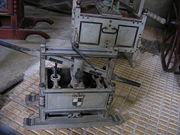
Litter (vehicle)
The litter is a class of wheelless vehicles, a type of human-powered transport, for the transport of persons. Examples of litter vehicles include lectica , jiao [较] , sedan chairs , palanquin , Woh , gama...
are presented in an open building. Additionally, equipment for the horses including saddles, horse shoes and spurs, are on display in the museum. One of the exhibits, a manual firefighting pump dates back to the fire in the castle in 1893. The fire raged for three days because the connections on the modern firefighting equipment didn't match the castle's connections. Water had to be brought up by a human chain in buckets from the Danube to the castle.
Visiting the castle
The castle may only be visited as part of a tour. The tours are in German only, though translated guides are available. The castle is open in March and April from 9:30 am – 4:30 pm, May to October from 9:00 am – 5:00 pm, and November to February from 10:00 am – 3:30 pm.See also
- List of castles in Baden-Württemberg
- SigmaringenSigmaringenSigmaringen is a town in southern Germany, in the state of Baden-Württemberg. Situated on the upper Danube, it is the capital of the Sigmaringen district....
- Hohenzollern-SigmaringenHohenzollern-Sigmaringen-Noble jurisdictions:Prince Karl Eitel of Hohenzollern-Sigmaringen, and descendants of his nephew Ferdinand ruled over the Kingdom of Romania, as Karl Eitel did not have children...
German References
- Chronik der Grafen von Zimmern, 1564–1566, Band 1–3. Hrsg. Decker-Hauff, 1964/67
- Die Kunstdenkmäler Hohenzollerns, Band 2. Landkreis Sigmaringen, 1948
- Gerd Dörr: Schwäbische Alb, Burgen, Schlösser, Ruinen. HB-Bildstlas. 1988
- Wilhelm Gradmann: Burgen und Schlösser der Schwäbischen Alb. 1980
- Handbuch Historischer Stätten Deutschlands. Baden Württemberg. 1965
- Gustav Hebeisen: Schloß Sigmaringen In: Burgwart. 1924. Nr. 1/2 Fürstliches Hohenzollernsches Schloß Sigmaringen
- Prinz Johann Georg von Hohenzollern: Der Museumsbau in Sigmaringen In: Blätter des Landes Denkmalamt, 1962
- Alfons Kasper: Kunstwanderungen kreuz und quer der Donau. 1964
- Walter Kaufhold: Schloß Sigmaringen. Die Geschichte der Burg- u. der Schloßherren. In: Kunstführer Nr. 580. Verlag Schnell & Steiner. München 1953
- Walter Kaufhold, Rudolf Seigel: Schloß Sigmaringen und das Fürstliche Haus Hohenzollern. Konstanz 1966
- Walter Kaufhold, Das Fürstlich Hohenzollernsche Museum in Sigmaringen, Schnell Kunstführer Nr. 1269, Verlag Schnell & Steiner, München und Zürich 1981
- Peter Kempf: Schloß Sigmaringen mit Sammlungen In: Blätter des Schwäbischen Albvereins, Nr. 2, 1987. 1987
- Naturpark Obere Donau. Wanderführer 1964
- Wilfried Pfefferkorn: Burgen unseres Landes – Schwäbische Alb. 1962
- Günter Schmitt: Sigmaringen. In: Ders.: Burgenführer Schwäbische Alb. Band 3: Donautal. Wandern und entdecken zwischen Sigmaringen und Tuttlingen. S. 41–62. Biberacher Verlagsdruckerei. Biberach 1990. ISBN 3-924489-50-5
- Stammtafeln zur Geschichte der europäischen Staaten. Band 1 und 2. 1965
- Stefan Uhl: Buckelquader an Burgen. Manuskript. 1983
- Johann Nepomuk Vanotti: Geschichte der Grafen von Montfort und von Werdenberg. 1988
- Helmut Voith: Führer durch die Museen im Kreis Sigmaringen. 1986
- Eva Walter, Walter Pfündel: Strefzüge im Donautal. 1989
- Dr. Karl Theodor Zingeler und Georg Buck: Zollerische Schlösser, Burgen und Burgruinen in Schwaben. 1906
External links
- Castle Sigmaringen – official site

